Farmers Query through call
1.Whether KIRAN provide any training to the farmer?
-Mr. Stephan Shadap (Ri-bhoi,Nongthymmai), ElvitMukhim,R. Kharsati): 6th July, 2013
Answer: KIRAN does not directly provide any training programme. However it facilitates to organize trainings for the farmers. Training schedules will be sent to the farmers in the form of SMS as well as in the Training Calendar link of KIRAN website.
2.How to get Crossbred pigs?
-LastandingShylla (Nongkynteit): 6th July, 2013
Answer: Crossbred pigs can be got from:
- Pig Farm
ICAR Research Complex for NEH Region
Umiam, Meghalaya – 793103
Telephone: 0364 2570362
Mobile no: 09774066854
Fax: 0364-2570355
Email: icarzcu3@gmail.com (Official)
- Department of Veterinary and Animal Husbandry
Govt. of Meghalaya
Telephone: 0364 – 2548388
Mobile no:
Fax: 0364 2547456
Email: ahvt-meg@nic.in
- National Research Centre on PIG (NRC-Pig)
Indian Council of Agricultural Research
Rani (Near Airport), Guwahati- 781 131
Phone: 0361-2847195, 2847221
FAX: 0361-2847195
Email: nrconpig@rediffmail.com
- College of Veterinary Science
Assam Agricultural University
Khanapara, Guwahati-781022
Phone: +91361-2337700
E-mail: cvsguwahati.btisnet@nic.in
3.Any schemes/subsides for the farmer from ICAR?
- ShalanSylliang
Answer: There are few schemes under Tribal Sub Plan (TSP) and National Initiative on Climate Resilient Agriculture (NICRA) on selected and demonstration basis. However other Schemes/subsidies/funding agencies of farmers in North East Regions with their detail information can be got from KIRAN website in “Farmers Corner”.
4. How to get piglets?
-R.Kharsati
Answer: Same as Question no. 2
5. Price of the paddy seeder?
Answer: Rs. 2000 per one paddy seeder. Contact Division of Agricultural Engineering, ICAR Research Complex for NEH Region, Umiam, Meghalaya- 793103. Mobile: 08974206188 (Er. Sandip Mandel)
6.King chilies: Is application of fertilizer needed when it is transplanted? What type of fertilizer does organic effective?– Rosemary
Answer: In king chili the fertilizer requirement 10-15 ton FYM + 100:60:60 Kg NPK/h. But for organic production the requirement of FYM/ Pig Minor is 20-25 ton/h. The full dose of FYM/ Pig Minor, P (Phosphorous), K (Potassium) and half N (Nitrogen) should be given at the time of land preparation and the remaining dose of nitrogen should be given between 30-45 days after transplanting.
7.From where can he get the paddy seeder machine and the vegetables seeds?
- RomerKurbah
Answer: First part is same as Question No. 9. For vegetables seeds contact ATIC, ICAR Research Complex for NEH Region, Umiam, Meghalaya- 793103. Mobile: 09436108690 (Dr. A. K. Tripathi)
8.From where I can get groundnut seeds?
- R. Kharsati, SyndamonKhyriem
Answer: Contact ATIC, ICAR Research Complex for NEH Region, Umiam, Meghalaya- 793103. Mobile: 09436108690 (Dr. A. K. Tripathi)
9. Any toll free no.?
Answer: Not yet. However two mobile phone numbers are disseminated to the SMS recipients. The numbers are 094353455356 and 09612712808
10.When is the separation age of piglets from the mother?
Answer: Piglets can be separated from their mother at the age of 50 to 60 days depending on the health of piglets and mother pig.
11.How to make Jalkund? 
-ShalanSylliang (Umroi, Nongrah) LastandingShylla(Nongkynteit):
Answer:A simple and low-cost rainwater harvesting structure named Jalkund has been developed for storing rainwater in upper terrace conditions of this region. The different steps for preparing Jalkund and use of materials are as follows.
Step 1
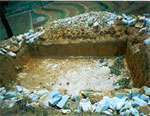 Excavation of the kund on selected site is to be completed before onset of monsoon. The bed and sides of the kund are to be leveled by removing rocks, stones or other projections, which otherwise might damage the lining material. Spraying of insecticide like endosulphon 35EC on surface of the inner walls and bottom and application of aluminum Phosphide @1 tablet /live hole around 5m of the kund are to be done before lining.
Excavation of the kund on selected site is to be completed before onset of monsoon. The bed and sides of the kund are to be leveled by removing rocks, stones or other projections, which otherwise might damage the lining material. Spraying of insecticide like endosulphon 35EC on surface of the inner walls and bottom and application of aluminum Phosphide @1 tablet /live hole around 5m of the kund are to be done before lining.
Step 2
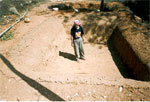 The inner walls including bottom of the kund are to be properly smoothened by plastering with mixture of clay and cow dung in the ratio of 5:1.
The inner walls including bottom of the kund are to be properly smoothened by plastering with mixture of clay and cow dung in the ratio of 5:1.
Step 3
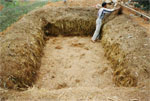 After clay plastering, about 3-5 cm thick cushioning is to be done with locally and easily available dry pine leaf @ 2 to 3 kg/m2 on the walls and bottom to avoid any kind of damage to the lining material from any sharp or conical gravel etc.
After clay plastering, about 3-5 cm thick cushioning is to be done with locally and easily available dry pine leaf @ 2 to 3 kg/m2 on the walls and bottom to avoid any kind of damage to the lining material from any sharp or conical gravel etc.
Step 4
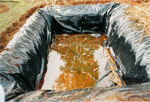 It is followed by laying down of 250 m LDPE black agri-film. The agri-film sheet is to be laid down in the kund in such a way that it touches the bottom and walls loosely and uniformly and stretched out to a width of about 50 cm all around the length and width of the kund. About 25 x 25 cm trench is to be dug all around the kund and 25 cm outer edge of agri-film is to be buried in the soil so that the film is tightly bound from all around.
It is followed by laying down of 250 m LDPE black agri-film. The agri-film sheet is to be laid down in the kund in such a way that it touches the bottom and walls loosely and uniformly and stretched out to a width of about 50 cm all around the length and width of the kund. About 25 x 25 cm trench is to be dug all around the kund and 25 cm outer edge of agri-film is to be buried in the soil so that the film is tightly bound from all around.
Step 5 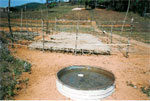
Jalkund is needed to be covered with thatch (5 – 8 cm thick) made of locally available bambooand grasses. Use of thatch reduce evaporation up to 80 % in comparison to the control Jalkund without any cover.
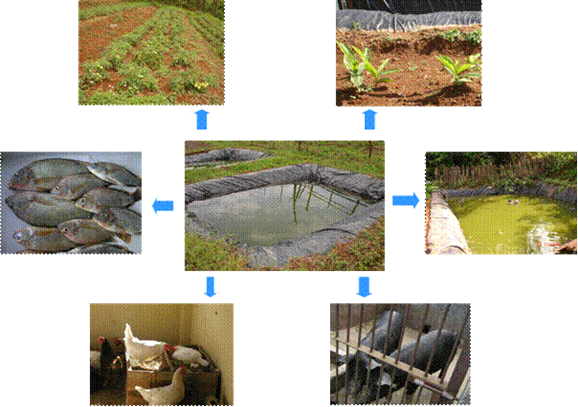
Diversified use of Jalkund water
Economic Viability
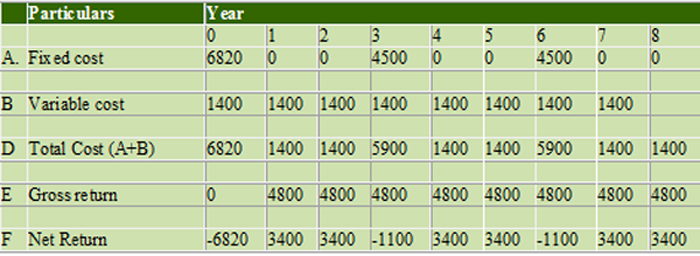
Note: Internal Rate of Return (IRR) is 31 %, Net Present Value (NPV) Rs 4096 and Benefit Cost Ratio 1.6
12.What is Azolla?
-ShalanSylliang(Umroi, Nongrah) LastandingShylla
Answer: Azolla dichotomously branched free floating aquatic fern is naturally available mostly on moist soils, ditch marshy ponds and is widely distributed in tropical belt of India. The shape of India species is typically triangular measuring about 1.5 to 3.0 cm in length 1 to 2 cm in breath. Roots emanating from growing branches remained suspended in water. The dorsal lobe which remain exposed to air is having a specific cavity containing its symbiotic partner, a Blue Green Algae (BGA)., the Anabaena Azollae. The fern is capable of fixing atmospheric nitrogen in the soil form of NH4+ and becomes available as a soluble nitrogen for the wet land rice crop, which is the major cereal for the people of the North East...read more.